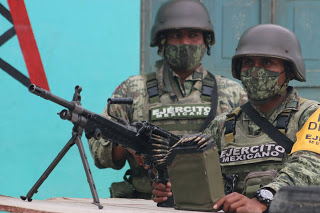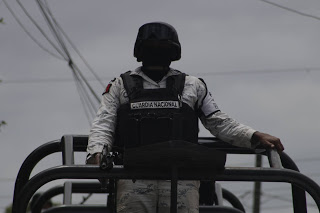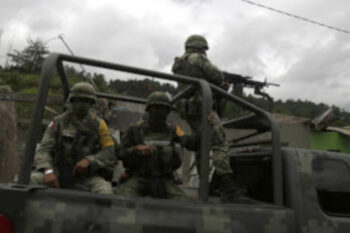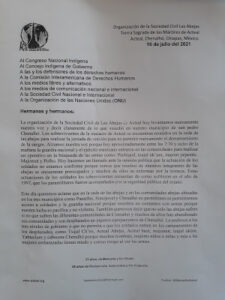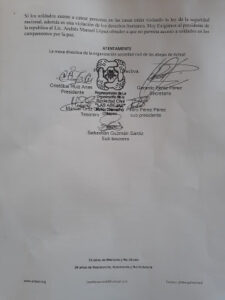
Mexico
(Español) Pronunciamiento de la Campaña U Jeets’el le Ki’ki kuxtal en el aniversario del inicio de la lucha social maya de 1847
Los pueblos mayas continuamos luchando por la defensa de nuestros territorios
¡por nuestras autonomías!
¡por la libertad!
De la “Guerra de Castas” a la Autonomía
Pronunciamiento de la Campaña U Jeets’el le Ki’ki kuxtal en el aniversario del
inicio de la lucha social maya de 1847
Al Ejército Zapatista de Liberación Nacional
Al Congreso Nacional Indígena / Concejo Indígena de Gobierno
Al Escuadrón 421 y a quienes integran las delegaciones en La Gira por la Vida
A los colectivos, organizaciones y pueblos de la Europa de abajo -la Tierra Insumisa, Slumil K´ajxemk´opA las Redes de Resistencia y Rebeldía
A la Sexta Nacional e Internacional
A los pueblos que luchan
A los medios de comunicación
Al pueblo maya de la península de Yucatán
1. La Guerra de ayer, herencia colonial
En la memoria de nuestros pueblos, de las abuelas y los abuelos mayas que habitan nuestros territorios ancestrales está presente la Gran Guerra. Aquella iniciada en 1847 en los pueblos de Tepich y Tihosuco en el oriente de la Península de Yucatán. La insurrección maya por la defensa de la libertad.
En la memoria de los pueblos viven los recuerdos de aquellos días en los que, decididos a terminar con la opresión, la explotación, los despojos y la muerte provocada por los malos gobiernos en complicidad con los hacendados que perpetuaban las condiciones de esclavitud colonial para los pueblos mayas; se levantaron en armas Cecilio Chí, Jacinto Pat y cientos de hombres y mujeresmayas para luchar por la dignidad y la justicia, iniciándose así una de las mayores rebeliones en el territorio maya.
Tal como lo habían hecho nuestros ancestros que desde el inicio de la invasión europea resistieron a los intentos de aniquilamiento de los pueblos originarios: Nachi Cocom, Jacinto Canek y muchos abuelos y abuelas mayas rebeldes.
En la memoria de los pueblos viven los recuerdo de la guerra: los enfrentamientos, la muerte, la sangre tiñendo las aguas cristalinas de los cenotes en medio de la selva; el recuerdo de tiempos de esconderse entre lo tupido del monte y habitar dentro de las cuevas sagradas; los tiempos de alimentarse con plantas silvestres, raíces, frutos e insectos a falta de maíz pues las milpas y sus cosechas eran destruidas por los de arriba, los malos gobiernos contra los que se luchaba.
Pero también vive la memoria de la autonomía conquistada con fusiles y con fe, la memoria de las fiestas ceremoniales. Viven los recuerdos de la música del mayapax con el violín, el bombo y la tarola: tan triste como sagrada; tan festiva como dolorosa. Vive la memoria de María Uicab, Vive la palabra de La Cruz Parlante que dirigía los combates y mantenía unidos a los insurrectos, porque la lucha por nuestro pueblo ha sido también una lucha espiritual; en las proclamas de la cruz kichkelen yuum con su palabra de lucha -pero también de amor y esperanza- guió a nuestros abuelos y abuelas. Hoy también continúa guiándonos. La lucha es desde nuestra raíz y existencia.
(Español) La tenaz búsqueda de verdad y justicia de familias, pueblos y personas victimizadas no pasará desapercibida

• Exigimos justicia para víctimas de graves violaciones a los derechos humanos y crímenes de lesa humanidad en México.
• Exigimos e impulsaremos la creación de una Comisión de la Verdad para el Esclarecimiento Histórico y un Mecanismo Internacional Contra la Impunidad
• Hacemos un llamado a poner un alto a la impunidad con acciones de abajo, pacíficas y organizadas desde la sociedad civil.
Quienes firmamos este pronunciamiento: El Centro para los Derechos Humanos Fray Juan de Larios (Fray Juan) y el Centro de Derechos Humanos Fray Bartolomé de Las Casas A.C. (Frayba) quienes, de Norte a Sur, reconocemos a pueblos y personas que han sido victimizadas, como Sujetas de Derechos, que con su acción y lucha digna, persistente y tenaz no han cesado, ni claudicado en la búsqueda de verdad y justicia por las graves violaciones a derechos humanos cometidas en su contra, en todo el territorio nacional.
Reconocemos como un mecanismo trascendental para nuestra democracia las Consultas Ciudadanas, contempladas en el marco jurídico mexicano, y esperamos que en un futuro se puedan realizar más ejercicios similares que puedan apoyar y promover el derecho de todas las personas a participar activamente en las decisiones de gobierno en cualquier ámbito de responsabilidad. El recurso de la Consulta popular, libre e informada puede ser un mecanismo en manos de la sociedad en la seria crisis de seguridad y derecho humanos en nuestro país.
Ante la consulta popular a realizarse en 1 de agosto, manifestamos:
Hasta ahora, el Estado mexicano ha sido incapaz de rendir cuentas en la investigación, identificación y castigo a los responsables de graves violaciones a derechos humanos y crímenes de lesa humanidad, asumiendo su responsabilidad ante la realidad de violencia e impunidad que vivimos.
En lo que va la actual administración federal no se observan decisiones contundentes de gobierno encaminadas a atender de fondo la seria crisis de justicia en nuestro país. Muestra de ello es el reconocimiento oficial1 de 89,488 registros de personas que siguen desaparecidas al mes de julio del 2021, y que día a día se incrementa. En lo que va de este sexenio han desaparecido 21,546 personas.
Asimismo, la Comisión Nacional de Búsqueda reconoce la intervención en 1,749 fosas clandestinas, con la recuperación de 3,025 cuerpos, de los cuales se han retornado a casa 822. Solo en Coahuila, existen aproximadamente mil cuerpos sin identificar, que fueron inhumados arbitrariamente en panteones municipales y más de 100mil fragmentos de restos recuperados en campos de exterminio.
Actualmente en el país, las Fiscalías se niegan a aportar datos certeros de cuerpos sin identificar bajo su custodia, pero se habla de por los menos 38mil hasta el 2019.
Más de 340mil personas desplazada por diferentes tipos de violencias. De enero a junio de este año se sumaron 3,873 personas desplazadas, datos que se pueden corroborar porque son públicos2.
De enero a junio del 2021, se registraron oficialmente 543 feminicidios, es decir 90 mujeres por mes oficialmente se les asesina en nuestro país3.
Y podemos seguir con más datos de las cadenas de injusticia e impunidad que mantiene a nuestros pueblos masacrados y en el terror. Cómo se puede hablar de Estado democrático de Derecho ante esta crisis humanitaria, de seguridad y de derechos humanos que vivimos por décadas, y en las que gobiernos van y vienen y todo se mantiene avanzando hacia horizontes de exterminio.
Saludamos el ejercicio ciudadano de la Consulta Popular a realizarse este 1 de agosto, sin embargo, enfatizamos lo siguiente:
Las responsabilidades del Estado no se consultan. Los crímenes del pasado y del presente deben ser investigados y castigados, como exigencia irrenunciable para poder garantizar caminos de justicia y paz para nuestros pueblos en el campo y la ciudad.
Los derechos de las víctimas por graves violaciones a derechos humanos no se consultan. Todas y cada una de ellas tienen el derecho de poder acceder a la verdad y a la justicia que el Estado ha tolerado y/o participado por acción y omisión.
Es por lo que, independientemente del resultado de la Primera Consulta Popular en México:
• Exigimos e impulsaremos la creación de una Comisión de la Verdad para el Esclarecimiento Histórico y un Mecanismo Internacional Contra la Impunidad para garantizar de manera efectiva los derechos a la Verdad, Justicia, Reparación y No repetición de las atroces violaciones a los derechos humanos y crímenes de lesa humanidad que padecemos en nuestro país. Convocamos a organizarnos para la construcción de estas iniciativas, procesos y exigencias.
• Denunciamos y repudiamos las acciones que miembros de algunos partidos políticos u otros grupos sociales, están realizando con el envío de mensajes a la sociedad, convocando a no participar en la jornada del 1 de agosto, tachándola de inconstitucional e ilegal, lo cual es falso4. Sabemos que el ejercicio del Derecho a la Consulta va a afectar circuitos de impunidad de personas y grupos responsables de las masacres contra nuestros pueblos.
Confiamos en que la sociedad civil mexicana ejerza y defienda su derecho a la Consulta y a reorientar las acciones de gobierno para en verdad hacer el bien común. Hacemos un llamado a continuar con acciones organizadas ante la indiferencia gubernamental por las masacres a nuestras gentes, a manifestarnos contra la impunidad y a caminar al lado de las personas y pueblos que siguen siendo victimizados, mujeres y hombres que siguen en su digna exigencia de verdad, justicia y reparación.
Reafirmamos nuestro compromiso con quienes siguen siendo victimizadas por el sistema de injusticia e impunidad que impera en nuestro país.
¡No están solas, no están solos!
San Cristóbal de Las Casas, Chiapas; Saltillo, Coahuila; México
29 de julio de 2021
Descarga el Pronunciamiento conjunto aquí: Pronunciamiento Verdad y Justicia para las víctimas de graves violaciones a derechos humanos



